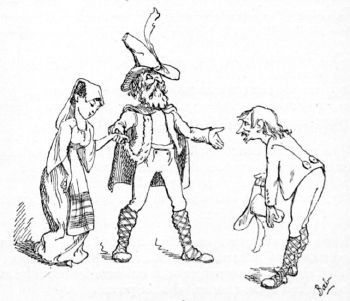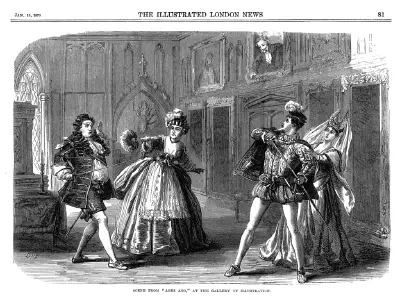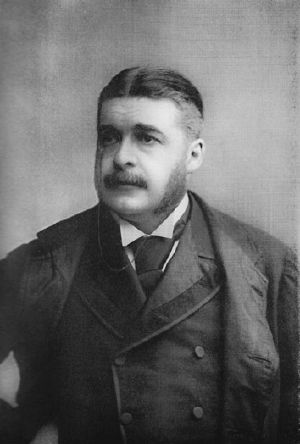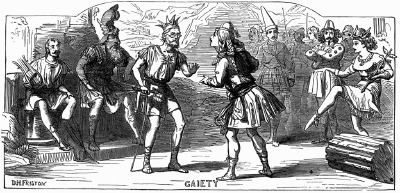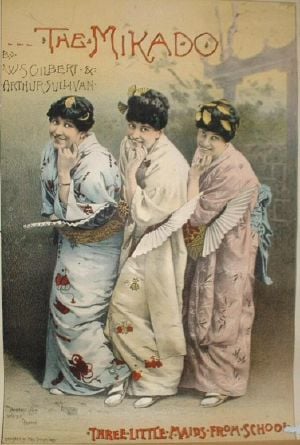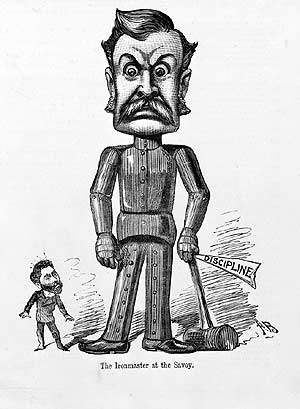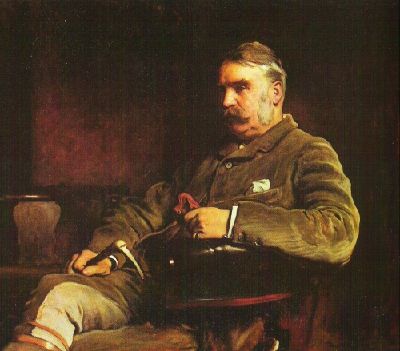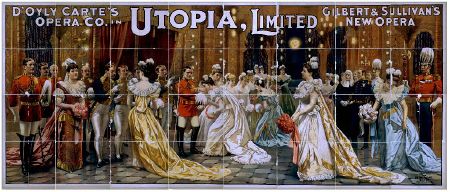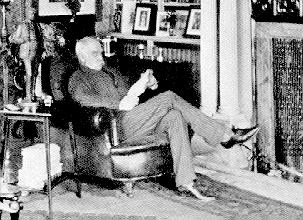W. S. Gilbert
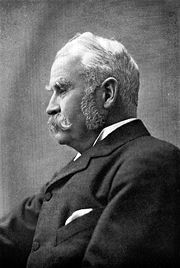 Sir William Schwenck Gilbert | |
| Born: | November 18 1836, London |
|---|---|
| Died: | 29 May 1911 (aged 74), Grim's Dyke |
| Occupation(s): | Dramatist |
| Influences: | Planché; Robertson |
| Influenced: | Oscar Wilde; George Bernard Shaw; Oscar Hammerstein |
Sir William Schwenck Gilbert (November 18, 1836 ‚Äď May 29, 1911) was an English dramatist, librettist, poet and illustrator best known for his 14 comic operas produced in collaboration with the composer Sir Arthur Sullivan, of which the most famous include H.M.S. Pinafore, The Pirates of Penzance, and one of the most frequently performed works in the history of musical theater, The Mikado.[1] These, as well as most of their other Savoy operas, continue to be performed regularly throughout the English-speaking world and beyond by opera companies, repertory companies, schools and community theater groups. Lines from these works have become part of the English language, such as "What never? Well, hardly ever!" and "Let the punishment fit the crime."[2]
Gilbert also wrote the Bab Ballads, an extensive collection of light verse accompanied by his own comical drawings. His creative output included over 75 plays and libretti, numerous stories, poems, lyrics and various other comic and serious pieces. His plays and realistic style of stage direction inspired other dramatists, including Oscar Wilde and George Bernard Shaw. According to The Cambridge History of English and American Literature, Gilbert's "lyrical facility and his mastery of metre raised the poetical quality of comic opera to a position that it had never reached before and has not reached since."[3]
Early Life and Career
Beginnings
Gilbert was born at 17 Southampton Street, Strand, London. His father, also named William, was a naval surgeon who later became a writer of novels and short stories, some of which were illustrated by his son. Gilbert's mother was the former Ann Morris. Gilbert's parents were distant and stern, and he did not have a particularly close relationship with either of them. Following the break-up of their marriage in 1876, his relationships with them, especially his mother, became even more strained. Gilbert had three younger sisters: Jane, Maude, and Florence.[4]
As a child, Gilbert traveled in Europe with his parents (they finally settled in London in 1849), and was educated at Boulogne, France (he later kept his diary in French so that the servants could not read it), and then at the Great Ealing School and King's College London, graduating in 1856. He applied for a military commission in the Gordon Highlanders, but, with the unexpected end of the Crimean War, fewer recruits were needed, and only a line commission was available to Gilbert. He served instead in the Civil Service for four years, but hated it. In 1859 he joined the newly formed Volunteer Army, with which he remained until 1878 (in between writing and other work), reaching the rank of Captain.[5][6] Finally, in 1863 he received a bequest of £300 that he used to leave the civil service and take up a brief career as a barrister, but he was not successful, averaging just five clients a year.
To supplement his income from 1861 on, Gilbert wrote a variety of stories, comic rants, theatre reviews (many in the form of a parody of the play being reviewed),[7] and, under the pseudonym "Bab" (his childhood nickname), illustrated poems for several comic magazines, primarily Fun, started in 1861 by H. J. Byron. The poems, illustrated humorously by Gilbert, proved immensely popular and were reprinted in book form as the Bab Ballads.[8] He would later return to many of these as source material for his various plays and comic operas. Gilbert and his colleagues from Fun, including Tom Robertson, Tom Hood, Clement Scott and F. C. Burnand (who defected to Punch in 1862) frequented the Arundel Club, the Savage Club, and especially Evans's café, where they had a table in competition with the Punch 'Round table'.[9]
Gilbert married Lucy Agnes Turner in 1867 (she was 11 years younger than he). He wrote many affectionate letters to her over the years. In addition, Gilbert and Lucy were socially active both in London and later at Grim's Dyke, often holding dinner parties and being invited to others' homes for dinner, in contrast to the picture painted by fictionalizations such as the film Topsy-Turvy (1999). Gilbert called his wife "Kitty," and although they had no children, they had many pets (including some exotic ones).[10][11]
First plays
Gilbert wrote and directed a number of plays at school, but his first professionally produced play was Uncle Baby, which ran for seven weeks in the autumn of 1863. David Eden suggests that this play was by, or in collaboration with, Gilbert's father,[12] although Andrew Crowther says that Eden gives no foundation for this suggestion.[13] In 1865‚Äď1866 he collaborated with Charles Millward on several pantomimes, including one called Hush-a-Bye, Baby, On the Tree Top, or, Harlequin Fortunia, King Frog of Frog Island, and the Magic Toys of Lowther Arcade (1866).[14] Gilbert's first solo success, however, came a few days after Hush-a-Bye Baby premiered. His friend Tom Robertson was asked to write a pantomime but did not think he could do it in the two weeks available, and so he recommended Gilbert instead. Written and rushed to the stage in ten days, Dulcamara, or the Little Duck and the Great Quack, a burlesque of Gaetano Donizetti's L'elisir d'amore, proved extremely popular. This led to a long series of further Gilbert burlesques, pantomimes and farces, full of awful puns (traditional in burlesques of the period),[15] though showing, at times, signs of the satire that would later be a defining part of Gilbert's work.[3] For instance:
| ‚Äú | That men were monkeys once‚ÄĒto that I bow; (looking at Lord Margate) I know one who's less man than monkey, now; That monkeys once were men, peers, statesmen, flunkies‚ÄĒ That's rather hard on unoffending monkeys![15] |
‚ÄĚ |
In Victorian theatre, "[to degrade] high and beautiful themes… had been the regular proceeding in burlesque, and the age almost expected it…."[3] However, Gilbert's burlesques were considered unusually tasteful compared to the others on the London stage, and he would depart even further from the burlesque style from about 1869 with plays containing original plots and fewer puns.[4]
Plays of the early 1870s
| CHRYSAL: This hound abused me!
ZORAM: He insulted me;
(To Zoram.)
(To Chrysal.)
CHRYSAL: I see‚ÄĒif that was only what he thought,
G√ČLANOR: What could he say?
CHRYSAL: Of course, I understand. Zoram, your hand! |
| - The Palace of Truth, 1870 |
Theater, at the time Gilbert began writing, had fallen into disrepute. Badly translated and adapted French operettas and poorly written, prurient burlesques dominated the London stage. As Jessie Bond vividly described it, "stilted tragedy and vulgar farce were all the would-be playgoer had to choose from, and the theatre had become a place of evil repute to the righteous British householder."[16]
From 1869 to 1875, Gilbert joined with one of the leading figures in theatrical reform, Thomas German Reed (and his wife Priscilla), whose Gallery of Illustration sought to regain some of theater's lost respectability by offering family entertainments in London.[16] Three months before the opening of Gilbert's last burlesque (The Pretty Druidess), the first of his pieces for the Gallery of Illustration, No Cards, was produced. Gilbert created six musical entertainments for the German Reeds, some with music composed by Thomas German Reed himself.
The environment of the German Reeds' intimate theater allowed Gilbert quickly to develop a personal style and freedom to control all aspects of production, including set, costumes, direction and stage management.[4] These works were a success,[17] with Gilbert's first big hit at the Gallery of Illustration, Ages Ago, opening in 1869. Ages Ago was also the beginning of a collaboration with the composer Frederic Clay that would last seven years and produce four works. It was at a rehearsal for Ages Ago that Clay formally introduced Gilbert to his friend, Arthur Sullivan. The Bab Ballads and Gilbert's many early musical works gave him much practice as a lyricist even before his collaboration with Sullivan.
Many of the plot elements of the German Reed Entertainments (as well as some from his earlier plays and Bab Ballads) would be reused by Gilbert later in the Gilbert and Sullivan operas. These elements include paintings coming to life (Ages Ago, used again in Ruddigore), a deaf nursemaid binding a respectable man's son to a "pirate" instead of to a "pilot" by mistake (Our Island Home, 1870, reused in The Pirates of Penzance), and the forceful mature lady who is "an acquired taste" (Eyes and No Eyes, 1875, reused in The Mikado). During this time, Gilbert perfected the 'topsy-turvy' style that he had been developing in his Bab Ballads, where the humor was derived by setting up a ridiculous premise and working out its logical consequences, however absurd. Mike Leigh describes the "Gilbertian" style as follows: "With great fluidity and freedom, [Gilbert] continually challenges our natural expectations. First, within the framework of the story, he makes bizarre things happen, and turns the world on its head. Thus the Learned Judge marries the Plaintiff, the soldiers metamorphose into aesthetes, and so on, and nearly every opera is resolved by a deft moving of the goalposts…. His genius is to fuse opposites with an imperceptible sleight of hand, to blend the surreal with the real, and the caricature with the natural. In other words, to tell a perfectly outrageous story in a completely deadpan way."[18]
At the same time, Gilbert created several 'fairy comedies' at the Haymarket Theatre. This series of plays was founded upon the idea of self-revelation by characters under the influence of some magic or some supernatural interference. The first was The Palace of Truth (1870), based on a story by Madame de Genlis. In 1871, with Pygmalion and Galatea, one of seven plays that he produced that year, Gilbert scored his greatest hit to date. Together, these plays and their successors such as The Wicked World (1873), Sweethearts (1874), and Broken Hearts (1875), did for Gilbert on the dramatic stage what the German Reed entertainments had done for him on the musical stage: they established that his capabilities extended far beyond burlesque, won him artistic credentials, and demonstrated that he was a writer of wide range, as comfortable with human drama as with farcical humor. The success of these plays, especially Pygmalion and Galatea, gave Gilbert a prestige that would be crucial to his later collaboration with as respected a musician as Sullivan.[19]
Though dated, these works demonstrate Gilbert's desire to give respectable and well-educated theatre audiences comedies that were more refined and tasteful than the usual farces and burlesques playing in London.[4] On the other hand, during the same period, Gilbert pushed the boundaries of how far satire could go in the theater. He collaborated with Gilbert Arthur à Beckett on The Happy Land (1873), a political satire (in part, a parody of his own The Wicked World), which was briefly banned because of its unflattering caricatures of Gladstone and his ministers.[4] Similarly, The Realm of Joy (1873) was set in the lobby of a theater performing a scandalous play (implied to be the Happy Land), with many jokes at the expense of the Lord Chamberlain (the "Lord High Disinfectant," as he's referred to in the play). In Charity (1874), however, Gilbert uses the freedom of the stage in a different way: to provide a tightly-written critique of the contrasting ways in which Victorian society treated men and women who had sex outside of marriage, which anticipated the 'problem plays' of Shaw and Ibsen.
Gilbert as a director
| "It is absolutely essential to the success of this piece that it should be played with the most perfect earnestness and gravity throughout. There should be no exaggeration in costume, make­up or demeanour; and the characters, one and all, should appear to believe, throughout, in the perfect sincerity of their words and actions. Directly the actors show that they are conscious of the absurdity of their utterances the piece begins to drag." |
| - Preface to Engaged |
Gilbert was the stage director for his plays and operas and had strong opinions on how they should best be performed. Gilbert was strongly influenced by the innovations in 'stagecraft', now called stage direction, by the playwrights James Planché and especially Tom Robertson.[16] Gilbert attended rehearsals directed by Robertson to learn this art firsthand from the older director, and he began to apply it in some of his earliest plays.[4] He sought realism in acting, if not in content of his plays (although he did write a romantic comedy in the "naturalist" style, as a tribute to Robertson, Sweethearts), shunned self-conscious interaction with the audience, and insisted on a standard of characterization where the characters were never aware of their own absurdity, but were coherent internal wholes.[20] In Gilbert's burlesque, Rosencrantz and Guildenstern (1874), the character Hamlet, in his speech to the players, sums up Gilbert's theory of comic acting: "I hold that there is no such antick fellow as your bombastical hero who doth so earnestly spout forth his folly as to make his hearers believe that he is unconscious of all incongruity." With his work along these lines, Gilbert set the ground for later playwrights such as George Bernard Shaw and Oscar Wilde to be able to flourish on the English stage.[4]
Robertson "introduced Gilbert both to the revolutionary notion of disciplined rehearsals and to mise-en-sc√®ne or unity of style in the whole presentation‚Äďdirection, design, music, acting."[18] Like Robertson, Gilbert insisted that his actors know their words perfectly and obey his stage directions, which was something quite new to many actors of the day.[20] "That Gilbert was a good director is not in doubt. He was able to extract from his actors natural, clear performances, which served the Gilbertian requirements of outrageousness delivered straight."[18] Even during long runs and revivals, Gilbert closely supervised the performances of his plays, making sure that the actors did not make unauthorized additions, deletions or paraphrases.[21] Gilbert was famous for demonstrating the action himself, even as he grew older. Gilbert himself went on stage in a number of productions throughout his lifetime, including several performances as the Associate in Trial by Jury, as substitute for an ailing actor in his play Broken Hearts, and in charity matinees of his one-act plays, such as King Claudius in Rosencrantz and Guildenstern.
The Collaboration with Sullivan
First collaborations amidst other works
In 1871, John Hollingshead commissioned Gilbert to work with Sullivan on a holiday piece for Christmas, Thespis, or The Gods Grown Old, at the Gaiety Theatre. Thespis outran five of its nine competitors for the 1871 holiday season and was later revived for a benefit performance. However, nothing more came of it at that point, and Gilbert and Sullivan went their separate ways. Gilbert worked again with Clay on Happy Arcadia (1872), and with Alfred Cellier on Topsyturveydom (1874), as well as writing several farces, operetta libretti, extravaganzas, fairy comedies, adaptations from novels, translations from the French, and the dramas described above. Also in 1874, he published his last contribution for Fun magazine ("Rosencrantz and Guildenstern"), after a gap of three years, then resigned due to disapproval of the new owner's other publishing interests.[22]
It would be nearly four years after Thespis was produced before the two men worked together again. In 1868, Gilbert had published a short comedic sketch libretto in Fun magazine entitled "Trial by Jury: An Operetta." In 1873, Gilbert arranged with the theatrical manager and composer, Carl Rosa, to expand the piece into a one-act libretto. Rosa's wife was to sing the role of the plaintiff. However, Rosa's wife died in childbirth in 1874. Later in 1874 Gilbert offered the libretto to Richard D'Oyly Carte, but Carte could not use the piece at that time. By early 1875, Carte was managing the Royalty Theatre, and he needed a short opera to be played as an afterpiece to Offenbach's La Périchole. He contacted Gilbert, asked about the piece, and suggested Sullivan to set the work. Sullivan was enthusiastic, and Trial by Jury was composed in a matter of weeks. The little piece was a runaway hit, outlasting the run of La Périchole and being revived at another theater.
Gilbert continued his quest to gain respect in and respectability for his profession. One thing that may have been holding dramatists back from respectability was that plays were not published in a form suitable for a "gentleman's library," as, at the time, they were generally cheaply and unattractively published for the use of actors rather than the reader. To help rectify this, at least for himself, Gilbert arranged in late 1875 for publishers Chatto and Windus to print a volume of his plays in a format designed to appeal to the general reader, with an attractive binding and clear type, containing Gilbert's most respectable plays, including his most serious works, but mischievously capped off with Trial by Jury.[4]
After the success of Trial by Jury, there were discussions towards reviving Thespis, but Gilbert and Sullivan were not able to agree on terms with Carte and his backers. The score to Thespis was never published, and most of the music is now lost. It took some time for Carte to gather funds for another Gilbert and Sullivan opera, and in this gap Gilbert produced several works including Tom Cobb (1875), Eyes and No Eyes (1875, his last German Reed Entertainment), and Princess Toto (1876), his last and most ambitious work with Clay, a three-act comic opera with full orchestra, as opposed to the shorter works for much reduced accompaniment that came before. Gilbert also wrote two serious works during this time, Broken Hearts (1875) and Dan'l Druce, Blacksmith (1876).
Also during this period, Gilbert wrote his most successful comic play, Engaged (1877), which inspired Oscar Wilde's The Importance of Being Earnest. Engaged is a parody of romantic drama written in the "topsy-turvy" satiric style of many of Gilbert's Bab Ballads and the Savoy Operas, with one character pledging his love, in the most poetic and romantic language possible, to every single woman in the play; the "innocent" Scottish rustics being revealed to be making a living through throwing trains off the lines and then charging the passengers for services, and, in general, romance being gladly thrown over in favor of monetary gain. Engaged continues to be performed today by both professional and amateur companies.
The peak collaborative years

Carte finally assembled a syndicate in 1877 and formed the Comedy Opera Company to launch a series of original English comic operas, beginning with a third collaboration between Gilbert and Sullivan, The Sorcerer, in November 1877. This work was a modest success,[4] and H.M.S. Pinafore followed in May 1878. Despite a slow start, mainly due to a scorching summer, Pinafore became a red-hot favorite by autumn. After a dispute with Carte over the division of profits, the other Comedy Opera Company partners hired thugs to storm the theater one night to steal the sets and costumes, intending to mount a rival production. The attempt was repelled by stagehands and others at the theater loyal to Carte, and Carte continued as sole impresario of the newly renamed D'Oyly Carte Opera Company. Indeed, Pinafore was so successful that over a hundred unauthorized productions sprang up in America alone. Gilbert, Sullivan and Carte tried for many years to control the American performance copyrights over their operas, without success.[23]
For the next decade, the Savoy Operas (as the series came to be known, after the theater Carte later built to house them) were Gilbert's principal activity. The successful comic operas with Sullivan continued to appear every year or two, several of them being among the longest-running productions up to that point in the history of the musical stage. After Pinafore came The Pirates of Penzance (1879), Patience (1881), Iolanthe (1882), Princess Ida (1884, based on Gilbert's earlier farce, The Princess), The Mikado (1885), Ruddigore (1887), The Yeomen of the Guard (1888), and The Gondoliers (1889). Gilbert not only directed and oversaw all aspects of production for these works, but he actually designed the costumes himself for Patience, Iolanthe, Princess Ida, and Ruddigore.
During this time, Gilbert and Sullivan also collaborated on one other major work, the oratorio The Martyr of Antioch, premiered at the Leeds music festival in October 1880. Gilbert arranged the original epic poem by Henry Hart Milman into a libretto suitable for the music, and it contains some original work. During this period, Gilbert occasionally wrote plays to be performed elsewhere ‚Äď both serious dramas (for example The Ne'er-Do-Weel, 1878) and humorous works (for example Foggerty's Fairy, 1881). However, he no longer needed to turn out multiple plays each year, as he had done before. Indeed, during the more than nine years that separated The Pirates of Penzance and The Gondoliers, he wrote just three plays outside of the partnership with Sullivan. Only one of these works, Comedy and Tragedy, proved successful.
In 1882, Gilbert had a telephone installed in his home and at the prompt desk at the Savoy Theatre, so that he could monitor performances and rehearsals from his home study. Gilbert had referred to the new technology in Pinafore in 1878, only two years after the device was invented and before London even had telephone service.[24]
The Carpet Quarrel and end of the collaboration
Gilbert sometimes had a strained working relationship with Sullivan, partly caused by the fact that each man saw himself allowing his work to be subjugated to the other's, and partly caused by the opposing personalities of the two‚ÄĒGilbert was often confrontational and notoriously thin-skinned (though prone to acts of extraordinary kindness), while Sullivan eschewed conflict. In addition, Gilbert imbued his libretti with "topsy-turvy" situations in which the social order was turned upside down. After a time, these subjects were often at odds with Sullivan's desire for realism and emotional content.[25][26] In addition, Gilbert's political satire often poked fun at those in the circles of privilege, while Sullivan was eager to socialize among the wealthy and titled people who would become his friends and patrons.[27]
Throughout their collaboration, Gilbert and Sullivan quarreled several times over the choice of a subject. After both Princess Ida and Ruddigore, which were less successful than the seven other operas from H.M.S. Pinafore through The Gondoliers, Sullivan asked to leave the partnership, saying that he found Gilbert's plots repetitive and that the operas were not artistically satisfying to him. While the two artists worked out their differences, Carte kept the Savoy open with revivals of their earlier works. On each occasion, after a few months' pause, Gilbert responded with a libretto that met Sullivan's objections, and the partnership was able to continue successfully.
During the run of The Gondoliers, however, Gilbert challenged Carte over the expenses of the production. Carte had charged the cost of a new carpet for the Savoy Theatre lobby to the partnership. Gilbert believed that this was a maintenance expense that should be charged to Carte alone. As scholar Andrew Crowther has explained:
After all, the carpet was only one of a number of disputed items, and the real issue lay not in the mere money value of these things, but in whether Carte could be trusted with the financial affairs of Gilbert and Sullivan. Gilbert contended that Carte had at best made a series of serious blunders in the accounts, and at worst deliberately attempted to swindle the others. It is not easy to settle the rights and wrongs of the issue at this distance, but it does seem fairly clear that there was something very wrong with the accounts at this time. Gilbert wrote to Sullivan on 28 May 1891, a year after the end of the "Quarrel," that Carte had admitted "an unintentional overcharge of nearly £1,000 in the electric lighting accounts alone."[28]
Sullivan sided with Carte, who was building a theater in London for the production of new English grand operas, with Sullivan's Ivanhoe as the inaugural work. While the protracted quarrel worked itself out in the courts and in public, Gilbert wrote The Mountebanks with Alfred Cellier and the flop Haste to the Wedding with George Grossmith.
In 1891, after many failed attempts at reconciliation by the pair, Tom Chappell, the music publisher responsible for printing the Gilbert and Sullivan operas, stepped in to mediate between two of his most profitable artists, and within two weeks had succeeded.[29] Two more operas resulted: Utopia, Limited (1893) and The Grand Duke (1896). Gilbert also offered a third libretto to Sullivan (His Excellency, 1894), but Gilbert's insistence on casting Nancy McIntosh, his protégée from Utopia, led to Sullivan's refusal.[30] Utopia, concerning an attempt to "anglicise" a South Pacific island kingdom, was only a modest success, and The Grand Duke, in which a theatrical troupe, by means of a "statutory duel" and a conspiracy, takes political control of a grand duchy, was an outright failure. After that, the partnership ended for good.[31] Sullivan continued to compose comic opera with other librettists but died four years later. In 1904, Gilbert would write, "…Savoy opera was snuffed out by the deplorable death of my distinguished collaborator, Sir Arthur Sullivan. When that event occurred, I saw no one with whom I felt that I could work with satisfaction and success, and so I discontinued to write libretti."[32]
Later years
Gilbert financed the building of the Garrick Theatre in 1889. He and Lady Gilbert moved to Grim's Dyke Harrow in 1890,[33] and, in 1891, was appointed Justice of the Peace for Middlesex.[34] After casting Nancy McIntosh in Utopia, Limited, he and Lady Gilbert developed an affection for her, and she eventually gained the status of an unofficially adopted daughter, moving to Grim's Dyke to live with them. She continued living there, even after Gilbert's death, until Lady Gilbert's death in 1936.
Although Gilbert announced a retirement from the theatre after the poor initial run of his last work with Sullivan, The Grand Duke (1896), he produced four more plays over the last 15 years of his life, including an unsuccessful opera, Fallen Fairies (1909), with Edward German.[35] Gilbert also continued to supervise the various revivals of his works by the D'Oyly Carte Opera Company.[36] His last play, The Hooligan, produced just four months before his death, is a study of a young condemned thug in a prison cell. The piece was so grim and powerful that, according to Mrs. Alec Tweedie, "women [in the audience] had gone out fainting." The Hooligan was one of Gilbert's most successful serious dramas, and experts conclude that, in those last months of Gilbert's life, he was developing a new style, a "mixture of irony, of social theme, and of grubby realism,"[37] to replace the old "Gilbertianism" that he had grown weary of.
Gilbert was knighted on July 15, 1907 in recognition of his contributions to drama.[38] Sullivan had been knighted for his contributions to music almost a quarter of a century earlier, in 1883. Gilbert was, however, the first British writer ever to receive a knighthood for his plays alone‚ÄĒearlier dramatist knights, such as Sir William Davenant and Sir John Vanbrugh, were knighted for political and other services.[39]
On May 29, 1911, Gilbert was giving swimming lessons to two young ladies in the lake of his home Grim's Dyke when one of them lost her footing and called for help. Gilbert dived in to save her, but suffered a heart attack in the middle of the lake and drowned.[4] His ashes were buried at the Church of St. John the Evangelist, Stanmore. The inscription on Gilbert's memorial on the south wall of the Thames Embankment in London reads: "His Foe was Folly, and his Weapon Wit."[18]
Legacy

Jessie Bond wrote that Gilbert "was quick-tempered, often unreasonable, and he could not bear to be thwarted, but how anyone could call him unamiable I cannot understand."[40] Aside from his occasional creative disagreements with, and eventual rift from, Sullivan, Gilbert's temper led to the loss of friendships with a number of people. For instance, he quarrelled with his old associate C. H. Workman over the firing of Nancy McIntosh from the production of Fallen Fairies. He also saw his friendship with theater critic Clement Scott turn bitter. However, Gilbert could be extraordinarily kind. During Scott's final illness in 1904, for instance, Gilbert donated to a fund for him, visited nearly every day, and assisted Scott's wife,[41] despite having not been on friendly terms with him for the previous 16 years.[42] Similarly, Gilbert had written several plays at the behest of comic actor Ned Sothern. However, Sothern died before he could perform the last of these, Foggerty’s Fairy. Gilbert purchased the play back from his grateful wife.[43] As the writings about Gilbert by husband and wife Seymour Hicks and Ellaline Terriss (frequent guests at his home) vividly illustrate, Gilbert's relationships with women were generally more successful than his relationships with men.[44]
Gilbert's legacy, aside from building the Garrick Theatre and writing the Savoy Operas and other works that are still being performed or in print over a 125 years after their creation, is felt perhaps most strongly today through his influence on the American and British musical theater. The innovations in content and form of the works that he and Sullivan developed, and in Gilbert's theories of acting and stage direction, directly influenced the development of the modern musical throughout the twentieth century.[20] Gilbert's lyrics employ punning, as well as complex internal and two and three-syllable rhyme schemes, and served as a model for such twentieth century Broadway lyricists as P.G. Wodehouse,[45] Cole Porter,[46] Ira Gershwin, and Lorenz Hart.
Gilbert's influence on the English language has also been marked, with well-known phrases such as "A policeman's lot is not a happy one," "short, sharp shock," "What never? Well, hardly ever!," and "let the punishment fit the crime" arising from his pen.[2] In addition, biographies continue to be written about Gilbert's life and work, and his work is not only performed, but frequently parodied, pastiched, quoted and imitated in comedy routines, film, television and other popular media.[47]
Notes
- ‚ÜĎ John Kenrick, G&S Story: Part III musicals101.com. Retrieved October 20, 2022.
- ‚ÜĎ 2.0 2.1 Edward Green, September 20, 2004, Ballads, songs, and speeches BBC News, September 20, 2004. Retrieved October 20,2022.
- ‚ÜĎ 3.0 3.1 3.2 T. W. Robertson, "Nineteenth-Century Drama." in The Cambridge History of English and American Literature (1907‚Äď1921), Volume XIII, Chapter VIII, Section 15. Bartelby.net. Retrieved October 20, 2022.
- ‚ÜĎ 4.0 4.1 4.2 4.3 4.4 4.5 4.6 4.7 4.8 4.9 Andrew Crowther, The Life of W. S. Gilbert Gilbert and Sullivan Archives. Retrieved October 20, 2022.
- ‚ÜĎ Jane W. Stedman, W. S. Gilbert, A Classic Victorian & His Theatre. (Oxford University Press, 1996, ISBN 0198161743), 5‚Äď6, 140, and 157.
- ‚ÜĎ Michael Ainger, Gilbert and Sullivan ‚Äď A Dual Biography (New York: Oxford University Press, 2002, ISBN 0195147693), 44, 49.
- ‚ÜĎ Jane W. Stedman, W. S. Gilbert's Theatrical Criticism (London: The Society for Theatre Research, 2000, ISBN 0854300686)
- ‚ÜĎ Stedman 1996, 26‚Äď29. See also the introduction to Gilbert, W.S. (1908), The Bab Ballads, etc, which details the history of the collections it was drawn from.
- ‚ÜĎ Stedman 1996, 16‚Äď18.
- ‚ÜĎ Ainger, 148
- ‚ÜĎ Stedman 1996, 318-320.
- ‚ÜĎ David Eden, Gilbert and Sullivan: The Creative Conflict (Fairleigh Dickinson University Press, 1986, ISBN 0838632823)
- ‚ÜĎ Andrew Crowther, Gilbert of Gilbert and Sullivan: His Life and Character (The History Press, 2011, ISBN 978-0752455891).
- ‚ÜĎ Stedman 1996, 34‚Äď35.
- ‚ÜĎ 15.0 15.1 W. S. Gilbert. La Viviandre, or, True to the Corps! (Liverpool: H. Montague, 1868) (a burlesque of Donizetti's The Daughter of the Regiment)
- ‚ÜĎ 16.0 16.1 16.2 Jessie Bond, The Life and Reminiscences of Jessie Bond, the Old Savoyard (as told to Ethel MacGeorge (The Gilbert and Sullivan Archive, 2008), Introduction.
- ‚ÜĎ Steadman 1996, 69‚Äď80.
- ‚ÜĎ 18.0 18.1 18.2 18.3 Mike Leigh 2006 interview The Guardian. Retrieved October 20, 2022.
- ‚ÜĎ Gayden Wren, A Most Ingenious Paradox: The Art of Gilbert & Sullivan (New York: Oxford University Press, 2001, ISBN 0195145143), 13.
- ‚ÜĎ 20.0 20.1 20.2 William Cox-Ife, W. S. Gilbert: Stage Director (London: Dobson, 1978, ISBN 0234772069).
- ‚ÜĎ Steadman 1996, 269 (quoting an April 30, 1890 letter from Gilbert to D'Oyly Carte).
- ‚ÜĎ John Bush Jones, "W.S. Gilbert's Contributions to Fun, 1865‚Äď1874," published in the Bulletin of the New York Public Library 73 (April 1969): 253‚Äď266.
- ‚ÜĎ Zvi S. Rosen, The Twilight of the Opera Pirates: A Prehistory of the Right of Public Performance for Musical Compositions Cardozo Arts & Entertainment Law Journal 24 (2007). Retrieved October 20, 2022.
- ‚ÜĎ Ian C. Bradley, Oh Joy! Oh Rapture! The Enduring Phenomenon of Gilbert and Sullivan (Oxford University Press, 2005, ISBN 0195167007), 176.
- ‚ÜĎ Ainger, 288
- ‚ÜĎ John Wolfson Final Curtain: The Last Gilbert and Sullivan Operas: including the unpublished rehearsal librettos and twenty unpublished Gilbert lyrics. (London: Chappell & Company Ltd, 1976, ISBN 0903443120), 3.
- ‚ÜĎ Arthur Jacobs, Arthur Sullivan ‚Äď A Victorian Musician (Portland, OR: Amadeus Press, 1992, ISBN 0859679055).
- ‚ÜĎ Andrew Crowther, The Carpet Quarrel Explained The Gilbert and Sullivan Archive. Retrieved October 20, 2022.
- ‚ÜĎ Wolfson, 7.
- ‚ÜĎ Wolfson, 61‚Äď65.
- ‚ÜĎ Wolfson, passim.
- ‚ÜĎ "Letter to the Editor," The Times (UK), Saturday, March 12, 1904, 9; Issue 37340; col C.
- ‚ÜĎ Stedman 1996, 278.
- ‚ÜĎ Steadman 1996, 281.
- ‚ÜĎ Wolfson, 102‚Äď103.
- ‚ÜĎ Wolfson, 102.
- ‚ÜĎ Stedman 1996, 343.
- ‚ÜĎ Ainger, 417‚Äď418
- ‚ÜĎ Stedman 1996, 328.
- ‚ÜĎ Bond, Chapter 16.
- ‚ÜĎ Clement Scott, Old Days in Bohemian London (Sagwan Press, 2015, ISBN 978-1340222291), 71‚Äď72.
- ‚ÜĎ Stedman 1996, 254-256 and 323-324
- ‚ÜĎ Ainger, 193‚Äď194.
- ‚ÜĎ Ellaline Terriss and Seymour Hicks, Views of W.S. Gilbert Gilbert and Sullivan Discography. Retrieved October 20, 2022.
- ‚ÜĎ PG Wodehouse (1881‚Äď1975) The Guardian, July 22, 2008. Retrieved October 20, 2022.
- ‚ÜĎ Lesson 35 ‚ÄĒ Cole Porter: You're the Top American Masters. Retrieved October 20, 2022.
- ‚ÜĎ Bradley 2005, Chapter 1
ReferencesISBN links support NWE through referral fees
- Ainger, Michael. Gilbert and Sullivan ‚Äď A Dual Biography. Oxford: Oxford University Press, 2009. ISBN 0195386930
- Benford, Harry. The Gilbert & Sullivan Lexicon. Ann Arbor, Michigan: The Queensbury Press, 1999. ISBN 0966791614
- Bond, Jessie. The Life and Reminiscences of Jessie Bond, the Old Savoyard (as told to Ethel MacGeorge). The Gilbert and Sullivan Archive, 2008. ASIN B005880SN8
- Bradley, Ian C. Oh Joy! Oh Rapture! The Enduring Phenomenon of Gilbert and Sullivan. Oxford University Press, 2005. ISBN 0195167007
- Bradley, Ian. The Complete Annotated Gilbert & Sullivan. Oxford, England: Oxford University Press, 2001. ISBN 0198167105
- Cox-Ife, William. W. S. Gilbert: Stage Director. Dobson, 1978. ISBN 0234772069
- Crowther, Andrew. Contradiction Contradicted ‚Äď The Plays of W. S. Gilbert. Associated University Presses, 2000. ISBN 0838638392
- Crowther, Andrew. Gilbert of Gilbert and Sullivan: His Life and Character. The History Press, 2011. ISBN 978-0752455891
- Eden, David. Gilbert and Sullivan: The Creative Conflict. Fairleigh Dickinson University Press, 1986. ISBN 0838632823
- Gilbert, W. S. Gilbert Before Sullivan - Six Comic Plays by W. S. Gilbert. Chicago: The University of Chicago Press, 1969. ISBN 0710028849
- Gilbert, W. S. The Bab Ballads, with which are included Songs of a Savoyard, 6th ed. London: MacMillan and Co., Limited, 1908. (A collection of material from several books published previously.)
- Gilbert, W. S. Foggerty's Fairy and Other Tales. London: George Routledge and Sons, 1890.
- Gilbert, W. S. in Peter Haining (ed.). The Lost Stories of W.S. Gilbert. London(?): Robson Books, 1985. (Contains mostly stories from Foggerty's Fairy and Other Tales.)
- Gilbert, W. S. Original Plays: First Series. London: Chatto and Windus, 1875.
- Gilbert, W. S. Original Plays: Second Series. London: Chatto and Windus, 1908.
- Gilbert, W. S. The Realm of Joy London: Nightingale Square: Terence Rees, 1969. ISBN 0950010812
- Jacobs, Arthur. Arthur Sullivan ‚Äď A Victorian Musician, Second Ed. Portland, OR: Amadeus Press, 1992. ISBN 0859679055
- Scott, Clement. Old Days in Bohemian London. Sagwan Press, 2015. ISBN 978-1340222291
- Stedman, Jane W. W. S. Gilbert, A Classic Victorian & His Theatre. Oxford University Press, 1996. ISBN 0198161743
- Stedman, Jane W. W. S. Gilbert's Theatrical Criticism. London: The Society for Theatre Research, 2000. ISBN 0854300686
- Sutton, Max Keith. W. S. Gilbert. Boston: Twayne, 1975. ISBN 0805712178
- Wolfson, John. Final Curtain: The Last Gilbert and Sullivan Operas: including the unpublished rehearsal librettos and twenty unpublished Gilbert lyrics. London: Chappell & Company Ltd., 1976. ISBN 0903443120
- Wren, Gayden. A most ingenious paradox : the art of Gilbert and Sullivan. Oxford University Press, 2001. ISBN 9780195145144
External links
All links retrieved May 3, 2023.
- The Gilbert and Sullivan Archive
- Works by W. S. Gilbert. Project Gutenberg
- W. S. Gilbert at the Internet Movie Database
- W. S. Gilbert Society Journal article about the discovery of a sketchbook claimed by the owner to be by Gilbert. The next issue published letters criticizing the attribution.
- Sir William Schwenck Gilbert: A Brief Biography Victorian Web
- W. S. Gilbert Discography of American Historical Recordings (DAHR)
| Gilbert and Sullivan | |
|---|---|
| The Triumvirate: W. S. Gilbert | Arthur Sullivan | Richard D'Oyly Carte | |
| The Gilbert and Sullivan Operas: Thespis ‚ÄĘ Trial by Jury ‚ÄĘ The Sorcerer ‚ÄĘ H.M.S. Pinafore ‚ÄĘ The Pirates of Penzance ‚ÄĘ Patience ‚ÄĘ Iolanthe ‚ÄĘ Princess Ida The Mikado ‚ÄĘ Ruddigore ‚ÄĘ The Yeomen of the Guard ‚ÄĘ The Gondoliers ‚ÄĘ Utopia, Limited ‚ÄĘ The Grand Duke | |
| Other Works, People and Related Matters: Other Works by W. S. Gilbert ‚ÄĘ Other Operas by Arthur Sullivan ‚ÄĘ Other Music by Arthur Sullivan People associated with Gilbert and Sullivan ‚ÄĘ Gilbert and Sullivan performers ‚ÄĘ Cultural influence of Gilbert and Sullivan | |
Credits
New World Encyclopedia writers and editors rewrote and completed the Wikipedia article in accordance with New World Encyclopedia standards. This article abides by terms of the Creative Commons CC-by-sa 3.0 License (CC-by-sa), which may be used and disseminated with proper attribution. Credit is due under the terms of this license that can reference both the New World Encyclopedia contributors and the selfless volunteer contributors of the Wikimedia Foundation. To cite this article click here for a list of acceptable citing formats.The history of earlier contributions by wikipedians is accessible to researchers here:
The history of this article since it was imported to New World Encyclopedia:
Note: Some restrictions may apply to use of individual images which are separately licensed.
